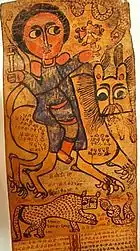Abuna Aregawi
Abuna Aregawi (also called Za-Mika'el 'Aragawi) was a sixth-century monk, whom tradition holds founded the monastery Debre Damo in Tigray, said to have been commissioned by Emperor Gebre Mesqel of Axum.
Saint Abuna Aregawi | |
|---|---|
| Born | 6th century |
| Died | Ethiopia |
| Venerated in | Ethiopian Orthodox Church |
| Feast | October 24–25 |

Narrative
He is one of the Nine Saints of the Ethiopian Orthodox Church who came from various parts of the Roman Empire to escape persecution after the Council of Chalcedon (451). The Nine Saints: Abba Aftsé, Abba 'Aléf, Abba Gärima, Abba Guba, Abba Liqanos, Abba Pantelewon, Abba Sehma, Abba Yäm'ata (Yemata) and Abba Zä-Mika'él 'Arägawi were learned monks who revitalized Christianity in Ethiopia, and to whom the Ge'ez version of the New Testament is attributed.
After spending twelve years at the court of king Ella Amida of Axum, he set out with his companion, the nun Edna, to found Debre Damo.[1] Later in his life, king Kaleb is said to have sought his advice before setting out to south Arabia against the Jewish king Dhu Nuwas.[2] He was a disciple of the famous Coptic monk Pachomius the Great who is regarded a founder of Cenobitic Monasticism.[3]
Debre Demo monastery
According to legend, God provided a large snake to aid Aregawi in climbing the amba, or steep-sided mountain, so he could build Debre Damo in Tigray. As David Buxton recounts the story, "when Abba Aragawi, the founder of the monastery, came to the foot of the cliff a great serpent appeared. As Michael the Archangel stood by to give directions, the serpent folded Abba Aregawi in his coils and drew him to the top of the mountain."[4] It is built with curved wood panels, painted ceilings and walls dedicated to the legend of Abuna Aregawi. Many books have been written there and distributed to churches throughout Ethiopia. There are a collection of some of the best manuscripts presently existing in Ethiopia.[5]
Abba Aregawi is a saint currently canonized by the Ethiopian Orthodox Tewahedo Church, as well as by the Ethiopian Catholic Church, as well as the Eritrean Orthodox Church. As one of the famous monks out of the nine Ethiopian Saints he was responsible for creating many monasteries and churches and was the main force behind installing monasticism in Ethiopia [4]
His feast day is on October 14 Ethiopian calendar (October 24 or 25 in Gregorian calendar).[6]
References
- Murphy, John. "Place of long prayer, long drop", The Baltimore Sun, July 10, 2001
- Biography of Zä-Mika'él 'Arägawi from The Dictionary of Ethiopian Biography Archived September 27, 2007, at the Wayback Machine
- Michael Daniel Ambatchew, Tales of Abuna Aregawi, Publisher: Createspace Independent Pub (10 April 2006), ISBN 978-1419632693 Retrieved on 21 Mar 2018
- David Buxton, Travels in Ethiopia, second edition (London: Benn, 1957), p. 126
- Shinn, David H. and Ofcansky, Thomas P., "Debre Damo", Historical Dictionary of Ethiopia, Scarecrow Press, 2013ISBN 9780810874572
- Debre Damo Archived 2018-01-29 at the Wayback Machine Retrieved on 21 Mar 2018
External links
